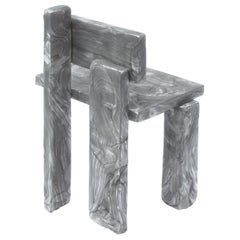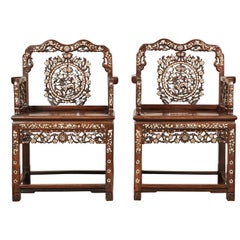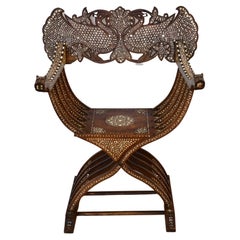Joost Dingemans Seating
1
to
1
1
1
1
1
Height
to
Width
to
Depth
to
1
1
1
1
1
3
1,340
1,168
1,142
1,081
Creator: Joost Dingemans
Mother of Pearl Chair by Marten and Joost
By Joost Dingemans, Marten van Middelkoop
Located in Geneve, CH
Mother of pearl chair
Sustainable design: Plastic waste into timeless design...?
- Measures: L 48 x W 54.5 x H 74.5 cm (Seat: H43.5cm)
- Recyc...
Category
2010s Dutch Organic Modern Joost Dingemans Seating
Materials
Resin
Related Items
19th Century Pair of Mother of Pearl Inlay Chairs
Located in Pasadena, CA
A pair of 19th century Chinese mother of pearl inlaid rosewood chairs. Embellished arms, legs and back with an intricately carved splat. Sold as a pair.
Category
19th Century Chinese Chinese Export Antique Joost Dingemans Seating
Materials
Mother-of-Pearl, Rosewood
Syrian Savonarola Chair with Mother of Pearl
Located in Brooklyn, NY
Syrian savonarola chair with elaborate mother of pearl inlay and etched faces at arms' end. Back and seat piece can be removed, pictured. Slight damage to the wood on back piece, als...
Category
19th Century Syrian Islamic Antique Joost Dingemans Seating
Materials
Mother-of-Pearl, Wood
Gerrit Rietveld Zeilmaker Version of Black Red and Blue Chair by Cassina
By Gerrit Rietveld, Cassina
Located in Barcelona, Barcelona
Chair designed by Gerrit Rietveld in 1920. Relaunched in 2015.
Manufactured by Cassina in Italy.
One of the versions of the iconic model dated 1918. The structure is in black-stained beechwood with white contrasting parts. Seat and back in green lacquered multiplywood. The armchair can have a single seat and backrest cushion in fabric or leather.
The black red and blue (Zeilmaker version) born from Rietveld’s chromatic experimentation
While researching the origins of the red and blue model in collaboration with the Rietveld heirs, it emerged that the key idea of the first prototypes was based on the concept of spatial organization expressed through the monochrome tones of its elements. The first version was in fact produced in 1918 in completely unpainted wood.
In the following years Rietveld proposed various examples, either monochrome or painted in different colors, depending on the requirements of his customers and the interiors for which the chairs were intended. As such, it comes as no surprise to find this 1920s version, presented as part of Cassina’s MutAzioni selection, created for the school teacher Wicher Zeilmaker with a black frame with white ends and a dark green painted seat and backrest.
It was Rietveld’s ever-increasing involvement in the De Stijl movement that led him to also use primary colors on this model in 1923, and as such the chair became a veritable manifesto for the emerging neoplastic movement. Initially dubbed slat chair, Rietveld only gave it the name red and blue in the 1950s following its chromatic evolution.
The various owners of the different examples used the chair as an abstract-realist sculpture in their interiors and, in some cases, as a simple tool for sitting on, adding cushions to make it more comfortable, just like Cassina offers for the black red and blue today.
Production delay:
8-9 weeks
Important information regarding images of products:
Please note that some of the images show other colors and variations of the model, these images are only to present interior design proposals. The item that is selling is on the first image.
Important information regarding color(s) of products:
Actual colors may vary. This is due to the fact that every computer monitor, laptop, tablet and phone screen has a different capability to display colors and that everyone sees these colors differently. We try to edit our photos to show all of our products as life-like as possible, but please understand the actual color may vary slightly from your monitor
About the designer:
Gerrit Thomas Rietveld, born in Utrecht on 24 June 1888, seems possessed of two personalities, each so distinct that one might take his work to be that of more than one artist. The first personality is that seen in the craftsman cabinet-maker working in a primordial idiom, re-inventing chairs and other furniture as if no one had ever built them before him and following a structural code all of his own; the second is that of the architect working with elegant formulas, determined to drive home the rationalist and neoplastic message in the context of European architecture. The two activities alternate, overlap, and fuse in a perfect osmosis unfolding then into a logical sequence. In 1918 Rietveld joined the “De Stijl” movement which had sprung up around the review of that name founded the year before by Theo van Doesburg. The group assimilated and translated into ideology certain laws on the dynamic breakdown of compositions (carrying them to an extreme) that had already been expressed in painting by the cubists: the “De Stijl” artists also carefully studied the architectonic lesson taught by the great Frank Lloyd Wright, whose influence was widely felt in Europe at that time.
Collaborating first with Robert van’t Hoff and Vilmos Huszar, then with Theo van Doesburg and Cornelius van Eesteren, Rietveld soon became one of the most distinguished interpreters of the neoplastic message.
Among his most important works are:
the Schröder house at Utrecht (1924); the “Row Houses” at Utrecht (1931-1934); the Dutch pavilion at the Venice Biennial (1954); the sculpture pavilion in the Rijksmuseum Kröller-Müller at Otterloo and the Van Gogh Museum in Amsterdam (1955). Out of his equally important furniture, Cassina has chosen for its own production: the “Red and Blue” (1918), the “Zig-Zag” (1934), the “Schröder 1...
Category
2010s Italian Mid-Century Modern Joost Dingemans Seating
Materials
Wood, Leather
H 34.65 in W 27.17 in D 32.68 in
Middle Eastern Mother of Pearl Inlaid Armchair
Located in West Palm Beach, FL
Vintage Mother of Pearl & inlaid wood Middle Eastern arm chair.
Category
20th Century Unknown Joost Dingemans Seating
Materials
Wood, Mother-of-Pearl
Gerrit Rietveld Zeilmaker Version of Black Red and Blue Chair by Cassina
By Gerrit Rietveld, Cassina
Located in Barcelona, Barcelona
Chair designed by Gerrit Rietveld in 1920. Relaunched in 2015.
Manufactured by Cassina in Italy.
One of the versions of the iconic model dated 1918. The structure is in black-stained beechwood with white contrasting parts. Seat and back in green lacquered multiplywood.
The black red and blue (Zeilmaker version) born from Rietveld’s chromatic experimentation
While researching the origins of the red and blue model in collaboration with the Rietveld heirs, it emerged that the key idea of the first prototypes was based on the concept of spatial organization expressed through the monochrome tones of its elements. The first version was in fact produced in 1918 in completely unpainted wood.
In the following years Rietveld proposed various examples, either monochrome or painted in different colors, depending on the requirements of his customers and the interiors for which the chairs were intended. As such, it comes as no surprise to find this 1920s version, presented as part of Cassina’s MutAzioni selection, created for the school teacher Wicher Zeilmaker with a black frame with white ends and a dark green painted seat and backrest.
It was Rietveld’s ever-increasing involvement in the De Stijl movement that led him to also use primary colors on this model in 1923, and as such the chair became a veritable manifesto for the emerging neoplastic movement. Initially dubbed slat chair, Rietveld only gave it the name red and blue in the 1950s following its chromatic evolution.
The various owners of the different examples used the chair as an abstract-realist sculpture in their interiors and, in some cases, as a simple tool for sitting on, adding cushions to make it more comfortable, just like Cassina offers for the black red and blue today.
Important information regarding images of products:
Please note that some of the images show other colors and variations of the model, these images are only to present interior design proposals. The item that is selling is on the first image.
Important information regarding color(s) of products:
Actual colors may vary. This is due to the fact that every computer monitor, laptop, tablet and phone screen has a different capability to display colors and that everyone sees these colors differently. We try to edit our photos to show all of our products as life-like as possible, but please understand the actual color may vary slightly from your monitor
About the designer:
Gerrit Thomas Rietveld, born in Utrecht on 24 June 1888, seems possessed of two personalities, each so distinct that one might take his work to be that of more than one artist. The first personality is that seen in the craftsman cabinet-maker working in a primordial idiom, re-inventing chairs and other furniture as if no one had ever built them before him and following a structural code all of his own; the second is that of the architect working with elegant formulas, determined to drive home the rationalist and neoplastic message in the context of European architecture. The two activities alternate, overlap, and fuse in a perfect osmosis unfolding then into a logical sequence. In 1918 Rietveld joined the “De Stijl” movement which had sprung up around the review of that name founded the year before by Theo van Doesburg. The group assimilated and translated into ideology certain laws on the dynamic breakdown of compositions (carrying them to an extreme) that had already been expressed in painting by the cubists: the “De Stijl” artists also carefully studied the architectonic lesson taught by the great Frank Lloyd Wright, whose influence was widely felt in Europe at that time.
Collaborating first with Robert van’t Hoff and Vilmos Huszar, then with Theo van Doesburg and Cornelius van Eesteren, Rietveld soon became one of the most distinguished interpreters of the neoplastic message.
Among his most important works are:
the Schröder house at Utrecht (1924); the “Row Houses” at Utrecht (1931-1934); the Dutch pavilion at the Venice Biennial (1954); the sculpture pavilion in the Rijksmuseum Kröller-Müller at Otterloo and the Van Gogh Museum in Amsterdam (1955). Out of his equally important furniture, Cassina has chosen for its own production: the “Red and Blue” (1918), the “Zig-Zag” (1934), the “Schröder 1...
Category
2010s Italian Mid-Century Modern Joost Dingemans Seating
Materials
Leather, Wood
H 34.65 in W 27.17 in D 32.68 in
4 Syrian Mother of Pearl Folding Scribe Chairs
Located in Dallas, TX
Group of four Syrian mother of pearl inlaid wooden folding scribe chairs including one matching pair. The carved wood is inlaid with intricate geometric and floral designs of mother ...
Category
20th Century Joost Dingemans Seating
Materials
Mother-of-Pearl, Wood
Pair of "Lens" Chairs by G. Offredi Plum Velvet and Chrome, Saporiti Italy 1968
By Giovanni Offredi, Saporiti
Located in Roma, IT
Marvellous midcentury pair of armchairs with tubular steel structure and plum fabric seats. "Lens" model was designed by Giovanni Offredi and produced for Saporiti, around 1968 in Italy.
These items are made of a stunning new stain-resistant, fire-retardant plum velvet. A magnificent and iconic set that will be perfect for a living room or study, thanks to the brightness of the chromed steel structure.
These pieces are in great vintage conditions as shown in the photos. A magnificent and iconic pair of pieces that will be perfect for a living room or study.
The shipping quote refers to the chairs shipped with the seating disassembled from the chromed base.
Giovanni Offredi (born 1927, Milan–died 2007, Milan) was a prominent Italian furniture and product designer of the second half of the 20th century. As opposed to most of the other Italian furniture designers of his time, Giovanni Offredi was not an architect, nor did he start designing early in his professional career. Instead, Offredi partially fits the career path of some of the talented contemporary designers who pursue product design outside of a formal education in architecture.
The earliest furniture design work known by Giovanni Offredi consists of exemplary furnishings made specifically for some of the wealthy families in Milan. Such is the case of the works done by Offredi for Casa C., in 1960, in Gorgonzola, a small town 14 miles from Milan. These works were designed with a surprisingly minimal simplicity and elegance, and they also clearly display a hallmark of his design work with the use of angular lines and exposed metal or wood frames—not unlike some of the modern Scandinavian design of the time.
In the late 1960s, Giovanni Offredi met Sergio Saporiti, the owner of Italian design shop and furniture maker Saporiti, and in 1970, Offredi formalized a partnership with the furniture maker. This partnership would be long and successful and resulted in many furniture designs of distinct precision that were clearly modern and innovative and that went on to enjoy considerable commercial success.
The most prominent furniture designs that Offredi made for Saporiti include the Paracarro table...
Category
1960s Italian Mid-Century Modern Vintage Joost Dingemans Seating
Materials
Steel, Stainless Steel, Chrome
H 29.93 in W 22.05 in D 24.41 in
Pair of Italian Steel and Bronze Chairs
Located in Nashville, TN
Savonarola style folding chairs with Curule form bases. Backs and seats are gilt embossed taupe suede. Four bronze finials.
Category
19th Century Italian Antique Joost Dingemans Seating
Materials
Bronze, Steel
Stunning Edwardian Bow Back Walnut Chair Arts & Crafts Mother of Pearl Inlay
Located in GB
We are delighted to offer for sale this lovely hand made in England walnut frame bow back armchair with mother of pearl inlay in the arts of crafts style
A good looking and decora...
Category
Early 20th Century English Arts and Crafts Joost Dingemans Seating
Materials
Mother-of-Pearl, Walnut
H 27.76 in W 21.26 in D 16.93 in
Pair of Armchair and Windsor Chair by Lucian Randolph Ercolani
By Lucian Ercolani
Located in Saint Ouen, FR
Pair of Armchair and Windsor chair by Lucian Randolph Ercolani
Ercol Edition
circa 1960
Elm and beech
Measures: 97 x 42 x 41 cm
In very ...
Category
1960s Italian Vintage Joost Dingemans Seating
Materials
Elm
Lounge Chair and Footstool by Warren Platner, 1966
By Warren Platner
Located in Berlin, Berlin
VINTAGE Easy chair and footstool designed by Warren Platner. U.S.A, Knoll International, 1966.
The lounge chair, model number 1725. Welded curved steel and wool upholstery. Beautifu...
Category
1960s American Modern Vintage Joost Dingemans Seating
Materials
Metal
Gerrit Rietveld Zeilmaker Version of Black Red and Blue Chair by Cassina
By Gerrit Rietveld, Cassina
Located in Barcelona, Barcelona
Chair designed by Gerrit Rietveld in 1920. Relaunched in 2015.
Manufactured by Cassina in Italy.
One of the versions of the iconic model dated 1918. The structure is in black-stained beechwood with white contrasting parts. Seat and back in green lacquered multiplywood.
The black red and blue (Zeilmaker version) born from Rietveld’s chromatic experimentation
While researching the origins of the red and blue model in collaboration with the Rietveld heirs, it emerged that the key idea of the first prototypes was based on the concept of spatial organization expressed through the monochrome tones of its elements. The first version was in fact produced in 1918 in completely unpainted wood.
In the following years Rietveld proposed various examples, either monochrome or painted in different colors, depending on the requirements of his customers and the interiors for which the chairs were intended. As such, it comes as no surprise to find this 1920s version, presented as part of Cassina’s MutAzioni selection, created for the school teacher Wicher Zeilmaker with a black frame with white ends and a dark green painted seat and backrest.
It was Rietveld’s ever-increasing involvement in the De Stijl movement that led him to also use primary colors on this model in 1923, and as such the chair became a veritable manifesto for the emerging neoplastic movement. Initially dubbed slat chair, Rietveld only gave it the name red and blue in the 1950s following its chromatic evolution.
The various owners of the different examples used the chair as an abstract-realist sculpture in their interiors and, in some cases, as a simple tool for sitting on, adding cushions to make it more comfortable, just like Cassina offers for the black red and blue today.
Important information regarding images of products:
Please note that some of the images show other colors and variations of the model, these images are only to present interior design proposals. The item that is selling is on the first image.
Important information regarding color(s) of products:
Actual colors may vary. This is due to the fact that every computer monitor, laptop, tablet and phone screen has a different capability to display colors and that everyone sees these colors differently. We try to edit our photos to show all of our products as life-like as possible, but please understand the actual color may vary slightly from your monitor
About the designer:
Gerrit Thomas Rietveld, born in Utrecht on 24 June 1888, seems possessed of two personalities, each so distinct that one might take his work to be that of more than one artist. The first personality is that seen in the craftsman cabinet...
Category
2010s Italian Mid-Century Modern Joost Dingemans Seating
Materials
Leather, Wood
H 34.65 in W 27.17 in D 32.68 in
Joost Dingemans seating for sale on 1stDibs.
Joost Dingemans seating are available for sale on 1stDibs. These distinctive items are frequently made of resin and are designed with extraordinary care. Prices for Joost Dingemans seating can differ depending upon size, time period and other attributes — on 1stDibs, these items begin at $6,642 and can go as high as $6,642, while a piece like these, on average, fetch $6,642.


